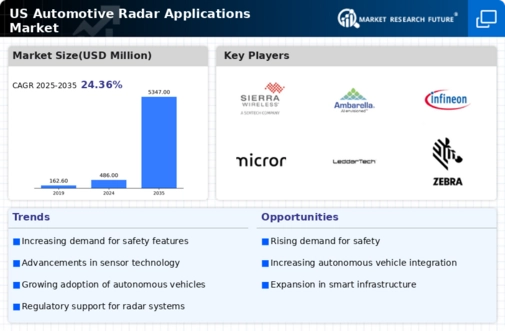Growth of Autonomous Vehicle Technologies
The growth of autonomous vehicle technologies is a significant driver for the automotive radar-applications market. As the industry moves towards fully autonomous vehicles, the demand for sophisticated radar systems that can accurately perceive the environment is increasing. These systems are essential for enabling features such as obstacle detection and navigation in complex driving scenarios. By 2025, it is projected that the market for autonomous vehicles will exceed $50 billion in the US, further propelling the need for advanced radar applications. The automotive radar-applications market is thus likely to thrive as automakers invest heavily in developing and integrating these technologies into their vehicle platforms.
Rising Demand for Enhanced Safety Features
The automotive radar-applications market is experiencing a notable surge in demand for enhanced safety features in vehicles. As consumers become increasingly aware of the importance of safety, manufacturers are compelled to integrate advanced radar systems into their vehicles. This trend is reflected in the growing adoption of Advanced Driver Assistance Systems (ADAS), which utilize radar technology to improve collision avoidance and pedestrian detection. In 2025, it is estimated that the market for ADAS will reach approximately $30 billion in the US, indicating a robust growth trajectory. The automotive radar-applications market is well-positioned to benefit significantly from this heightened focus on safety, as automakers strive to meet consumer expectations and regulatory requirements.
Consumer Preference for Smart Vehicle Features
Consumer preference for smart vehicle features is driving the automotive radar-applications market forward. As technology becomes more integrated into daily life, consumers are increasingly seeking vehicles equipped with smart features that enhance convenience and safety. Radar applications play a crucial role in enabling functionalities such as adaptive cruise control, blind-spot monitoring, and automated parking. In 2025, it is estimated that over 50% of new vehicles sold in the US will include some form of radar-based technology. This shift in consumer expectations is prompting manufacturers to prioritize the development of radar applications, thereby fostering growth in the automotive radar-applications market.
Technological Innovations Driving Market Growth
Technological innovations are playing a pivotal role in shaping the automotive radar-applications market. The introduction of high-resolution radar systems, capable of detecting objects at greater distances and with improved accuracy, is transforming the landscape of vehicle safety and automation. These advancements enable features such as adaptive cruise control and lane-keeping assistance, which are becoming standard in new vehicle models. The market is projected to grow at a CAGR of 15% from 2025 to 2030, driven by these innovations. As manufacturers invest in research and development, the automotive radar-applications market is likely to witness a continuous influx of cutting-edge technologies, enhancing the overall driving experience.
Increasing Regulatory Pressure for Safety Compliance
The automotive radar-applications market is influenced by increasing regulatory pressure for safety compliance. Government agencies in the US are implementing stringent safety standards that require automakers to equip vehicles with advanced safety technologies, including radar systems. This regulatory landscape is compelling manufacturers to prioritize the integration of radar applications in their vehicles to ensure compliance and avoid penalties. As of 2025, it is anticipated that nearly 70% of new vehicles will be required to have some form of radar-based safety technology. Consequently, the automotive radar-applications market is expected to expand as manufacturers adapt to these evolving regulations and consumer safety expectations.





















Leave a Comment